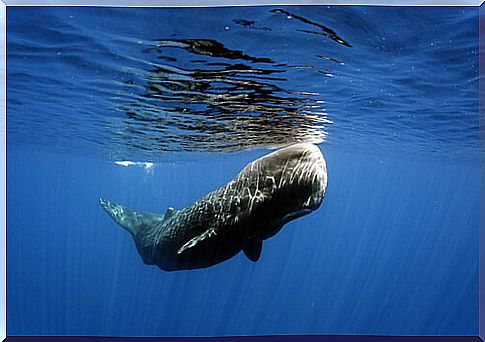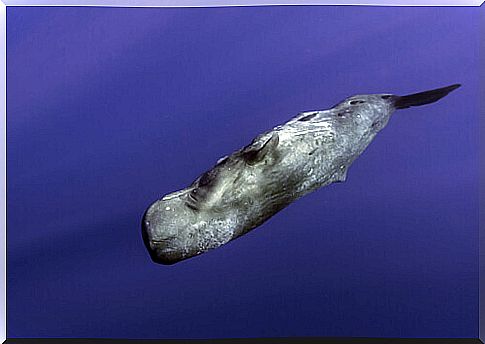The Sperm Whale, King Of The Deep

Its brain size exceeds that of any other creature on this planet. It is capable of descending to almost 1,000 meters of depth and of holding its breath for up to 90 minutes. Without a doubt, the sperm whale is one of the most fascinating creatures in the deep ocean.
Sperm whale characteristics
The sperm whale, scientifically named Physeter macrocephalus, it is a mammal belonging to the order of cetaceans. Within this order are the largest creatures: an adult male can reach 20.5 meters and weigh 57,000 kilograms.
At birth, the sperm whale is four meters tall and weighs a whopping 1,000 kilos. The only predator of this imposing creature is the killer whale, whose attacks it does not usually survive.
The sperm whale is easily recognizable by its grayish color and huge head. Its enormous size is due to the fact that, inside, the skull of these cetaceans hides a fluid of unknown function called spermaceti. At first the color and consistency led to think that it was sperm, although the function of this fluid is not yet known.
One of the most accepted theories relates it to the buoyancy of the cetacean. Thanks to its consistency, low temperatures solidify the liquid, which can weigh up to 40 kilograms.
In this way, it is easier for them to feed at almost 1,000 meters of depth and, thanks to the powerful capacity of their four stomachs, the sperm whale is able to ingest live giant squid.
Behavior
It is usual for the sperm whale to move in herds of about 15 or 20 specimens. The females are accompanied by their young and are more sedentary, while the males travel from herd to herd. Regarding the reproduction of these mammals, the gestation period ranges between 14 and 16 months and the mother can continue to breastfeed for up to three years.
Females practice communal rearing in tropical or subtropical waters. The males, for their part, tend to migrate to higher latitudes with other specimens; and they also move solo. The sperm whale is usually seen in areas of deep water and abundant biodiversity.

When the mating season arrives, the males move towards the equator to reproduce. Sperm whales, then, spend most of their lives in two different groups: first, in nurseries improvised by females with their young. Then l os males form ‘singles groups’, dedicated to migrate to hunt and reproduce.
A particular sense of direction
The fascinating habits of the sperm whale include an intricate system of sound waves. These cetaceans emit a kind of ‘clicks’, which they use both to communicate and for echolocation. This is that the emission of sound bands in the water are reflected by other bodies and structures, and allow you to know their topography.
Recalling the aforementioned spermaceti, this viscous fluid allows them to direct and project the waves produced. It is also believed that they can play an important role in their hunting habits, since the high frequencies at which they are emitted can serve to stun their prey.
The sperm whale in popular culture
During the 18th and 19th centuries, the sperm whale was the mainstay of the whaling industry due to the value of its oil and the so-called ambergris, a flammable and waxy secretion.
The intestines of the animal secrete it to facilitate the transit of foods that are difficult to digest, such as squid. Mainly, this substance was used as a fixative in perfumery, although it is currently replaced by synthetic compounds.
Despite the severe blow they suffered from whaling, it is not considered a threatened species. However, the International Union for Conservation of Nature (IUCN) considers it vulnerable.
The sperm whale also has a place in literature : let’s remember the mythical albino specimen of Moby-Dick. In Herman Melville’s novel, a whaler spends his days chasing the sperm whale that tore his leg off, in a mad obsession.
Apparently, the famous albino specimen existed under the name Mocha Dick and lived on the island of Mocha, in Chile. The fierce fights between this aggressive sperm whale and its hunters were recorded in a New York publication. In 1851 Herman Melville immortalized the figure of Moby Dick and that of the fascinating sperm whale.









